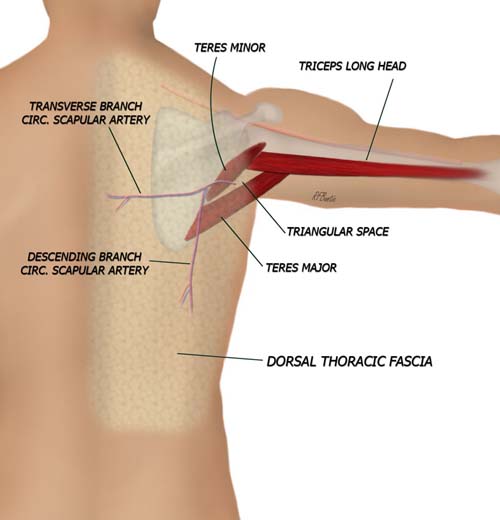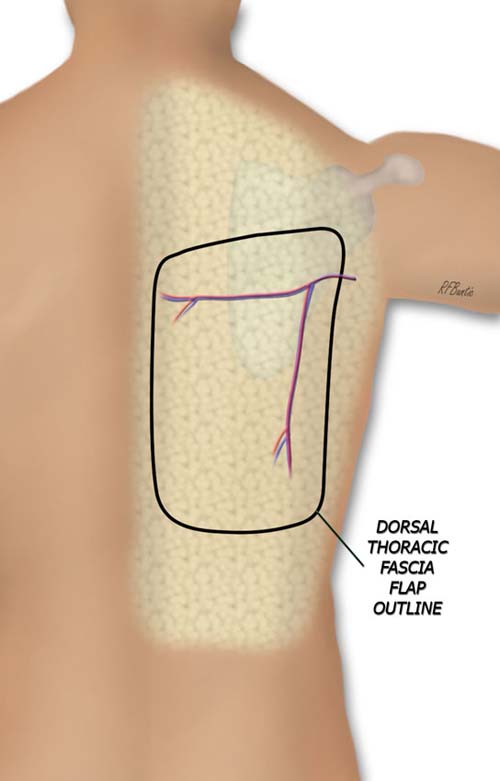Dorsal thoracic fascia flap
Anatomic considerations
The deep fascia of the back over the territory of the scapular and parascapular flaps provides a large potential area for thin tissue made entirely of fascia. The flap is large, thin and well vascularized and the anatomy is consitentent and reliable.
Vascular Anatomy
The transverse and descending branches of the circumflex scapular artery provide the major branches of the pedicle to this flap. The pedicle can be traced into the triangular space and followed to the suscapular artery and its origin at the axillary artery to gain length.

Vascular anatomy of the dorsal thoracic fascia. The circumflex scapular artery travels through the triangular space and divides into transverse and descending scapular branches. The dorsal thoracic fascia is supplied by these branches. Either one or both can be used depending on the size and orientation of the flap harvested.
Key landmarks are the scapular and triangular space. The superior lateral apex of the flap is centered over the triangular space, where the circumflex scapular artery enters the tissue of the back. The borders of the triangular space are made up of the
- Teres minor
- Teres major
- Long head of triceps
The circumflex scapular artery is a branch of the subscapular artery which takes origin off the axillary artery. The circumflex scapular arises about 1 to 4 centimeters from the origin of the subscapular artery, but can on occasion arise directly from the axillary artery. After the circumflex scapular artery pierces the triangular space it sprouts a transverse cutaneous scapular branch and a vertical parascapular branch. The parascapular branch forms the basis of the parascapular flap. The transverse branch supplies the scapular flap. The subscapular artery pedicle can be from 3 to 7 cm in length with vessel circumference at the proximal level up to 4 millimeters in size. Although the circumflex scapular artery is usually accompanied by two venae comitans, the subscapular artery is typically accompanied by one vein.
The flap area can be quite large, up to 20 by 25 centimeters. The potential area is outlined in the figure.

The area of dorsal thoracic fascia is quite large, and the potential area of flap harvest is correspondingly large. The fascia tends to thin inferiorly and medially.
The Operative Procedure
The patient is placed in the lateral decubitus position on a beanbag. Optionally, the prone position can be used if a posterior wound must be resurfaced. It can be more difficult since arm positioning can not be adjusted as easily as in the lateral decubitus position. The ipsilateral arm is left free and included in the operative scrub. A stockinette around the arm and Mayo stand with a well-padded pillow helps to rest the arm during surgery in the lateral position.

The incision is generally oriented transversely or slightly obliquely, with the axillary end of the incision over the triangular space.
The incision is marked using the scapula as a guide. The flap must include the triangular space within its border so the pedicle vessel is captured. A point roughly one fingerbreadth below the mid point of the scapula on its lateral aspect marks the triangular space. A pencil Doppler probe can help confirm the pedicle location. The triangular space marks the upper point of a lazy "S" incision that angles inferiroly and medially.
After the incision is made, the dissection proceeds through the fat, and stops just as the the areolar layer deep to the fat is encountered. The skin and fat flaps are then elevated superficial to the fascia, in the areolar plane. The undermining proceeds until the area of flap needed is exposed.

The upper flap is freed at the superior edge, then mediall and inferiorly and lifted from the plane superficial to the muscular fascia.
The upper edge of the flap is incised and elevated in the areloar plane below the fascia. This still leaves a fibrous muscular fascia below. This fibrous muscular fascia is elevated more laterally, just before the triangular space is reached. Inferiorly, the dorsal thoracic fascia is also scored. The dissection can then proceed from medial and inferior to lateral and superior.

Laterally the muscular fascia is is entered and elevated just before the triangular space is reached. The pedicle is easily identified and can then be traced into the triangular space.
As the dissection proceeds from medial to lateral, the layer deep to the muscular fascia is entered when the lateral aspect of the scapula is reached. When the circumflex scapular artery is encountered, the dissection can then proceed into the triangular space for pedicle length.

The pedicle is traced into the triangular space by using single or opposing self retaining retractors to open the areolar planes around the vessel. The ipsilateral arm can be repositioned to aid in exposure.
Post-Operative Care
The wound is closed over a suction drain and the patient is allowed motion with the ipsilateral arm as tolerated.
